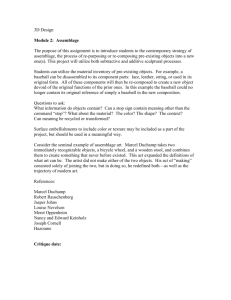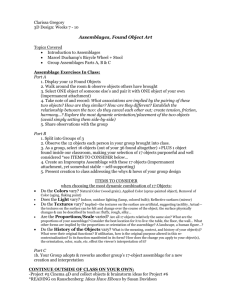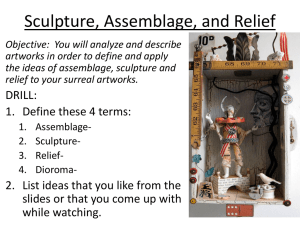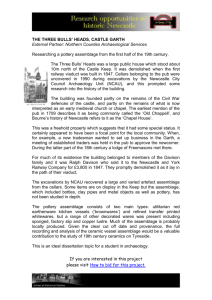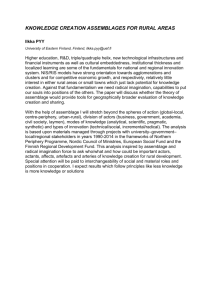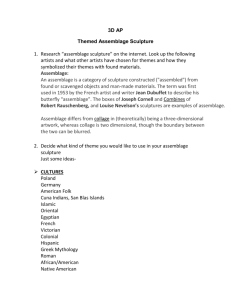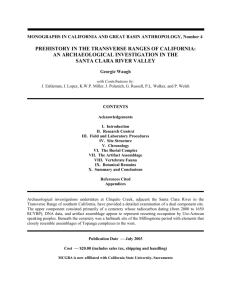Veritable Inventions: Cities, Policies, and Assemblage
advertisement
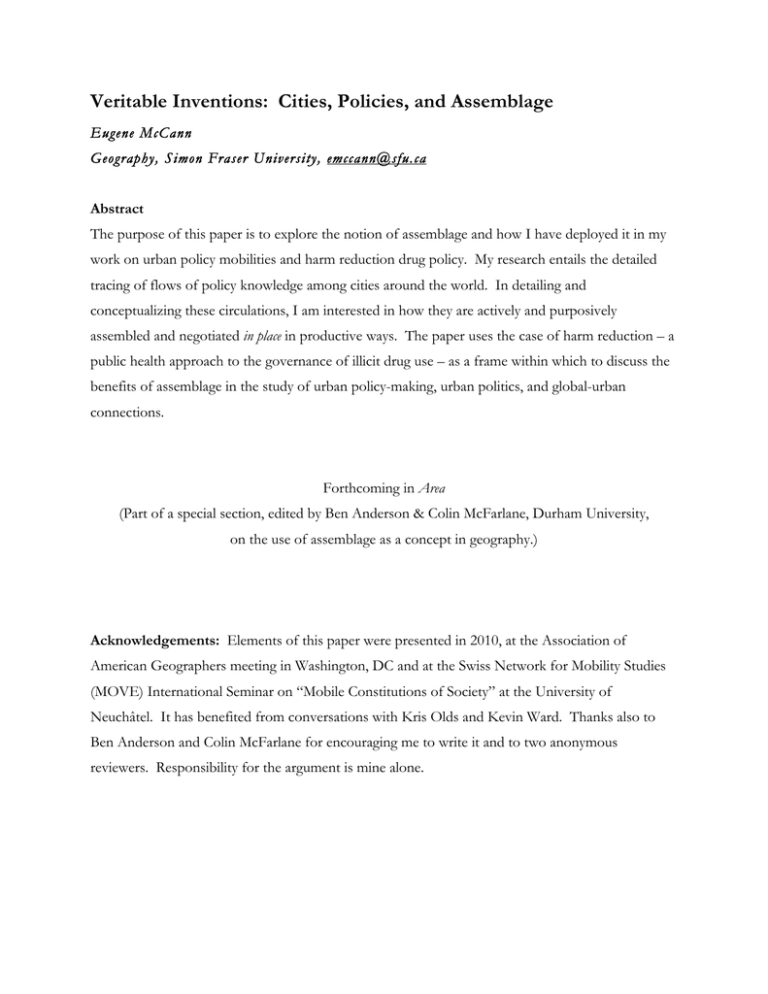
Veritable Inventions: Cities, Policies, and Assemblage Eugene McCann Geography, Simon Fraser University, emccann@sfu.ca Abstract The purpose of this paper is to explore the notion of assemblage and how I have deployed it in my work on urban policy mobilities and harm reduction drug policy. My research entails the detailed tracing of flows of policy knowledge among cities around the world. In detailing and conceptualizing these circulations, I am interested in how they are actively and purposively assembled and negotiated in place in productive ways. The paper uses the case of harm reduction – a public health approach to the governance of illicit drug use – as a frame within which to discuss the benefits of assemblage in the study of urban policy-making, urban politics, and global-urban connections. Forthcoming in Area (Part of a special section, edited by Ben Anderson & Colin McFarlane, Durham University, on the use of assemblage as a concept in geography.) Acknowledgements: Elements of this paper were presented in 2010, at the Association of American Geographers meeting in Washington, DC and at the Swiss Network for Mobility Studies (MOVE) International Seminar on “Mobile Constitutions of Society” at the University of Neuchâtel. It has benefited from conversations with Kris Olds and Kevin Ward. Thanks also to Ben Anderson and Colin McFarlane for encouraging me to write it and to two anonymous reviewers. Responsibility for the argument is mine alone. An assemblage [is] every constellation of singularities and traits deducted from the flow – selected, organized, stratified – in such a way as to converge … artificially and naturally; an assemblage, in this sense, is a veritable invention (Deleuze and Guattari, 1987, 406; their emphasis). The concept of assemblage serves an increasingly provocative and productive role in various geographical literatures. Certainly, in my current research on ‘policy mobilities,’ it has become a proverbial grain of sand that has usefully irritated my taken-for-granted assumptions about cities, policies, and global interconnections. My research on policy mobilities concerns how local policy actors engage with global communities by learning and teaching about models and ‘best practices,’ how these models are mobilized, how they are changed along the way, how these mobilities are socially conditioned, and how they shape specific places as well as regional, national, and global geographies (McCann, 2008, Forthcoming; McCann & Ward, 2010, In Press; Peck & Theodore, 2010a). I trace the flows of policies, policy models, and policy knowledge among cities via key communities, networks, institutions, infrastructures, and places. I am particularly interested in how key actors, ideas, and technologies are actively brought into productive co-presence in cities, in how certain absences are also presences in policy-making, as actors in one place refer to models elsewhere as they construct ‘local’ policies (Callon & Law, 2004; Sheller & Urry, 2006; McCann, In Press), and in what these mobilities and absent presences can tell us about the character of cities within wider global constellations of places, people, and power. Here I will use an example to address how assemblage has been useful to me and how it provokes further thoughts that might be valuable in the future. I am researching the case of Vancouver, British Columbia’s strategy for alleviating the harms caused by the consumption of illicit drugs, which has been official policy since 2001. It combines enforcement, treatment, prevention, and a commitment to reducing the harms of illicit drug use, rather than to eliminating their use. This four-pillar strategy was developed in the late 1990s in response to high rates of infection and overdose death among the city’s economically impoverished, often homeless or marginally-housed injection drug users. In the face of an officially-declared health crisis, policy-makers, politicians, frontline health and social service workers, some police officers, and a remarkable, diverse coalition of community and user activists identified the conventional criminalization approach to drug use as a major reason for Vancouver’s crisis. 2 Their response was an ‘extrospective’ one: to look to other parts of the world for a different approach (McCann, 2008, In Press). The ‘harm reduction’ approach, which has been most strongly institutionalized in the Netherlands, Germany, and Switzerland, quickly became the object of their learning and political activity. Harm reduction is most commonly associated with syringe exchange programs and methadone substitution. It avoids the ideal of a drug-free society, seeing it as unrealistic, and understands drug use to have a wide spectrum of effects, only some of which are extremely harmful to the individual and/or society. These are to be addressed primarily using a public health and social work model. Members of the coalition learned about harm reduction from German and Swiss cities like Frankfurt and Zürich. After the strategy’s ratification in 2001, Insite, a legal facility for the supervised consumption of illicit drugs that also acts as a low-threshold entryway into a range of other treatment and social services, was opened in 2003. Since the inception of the strategy there has been a noticeable decrease in drug-related deaths in Vancouver (Matas, 2008) and the benefits of Insite, including overdose prevention, reductions in HIV risk behavior (like sharing syringes), public injections and public disposal of syringes, and increased referrals to counseling and treatment have been convincingly demonstrated (Urban Health Research Initiative, 2009). Vancouver’s drug strategy is a ‘veritable invention,’ as Deleuze and Guattari put it. It involves labor (McFarlane, 2009): a purposive gathering of people, institutional capacities, expertise, models, techniques and technologies, political sustenance, etc. from local sources and, crucially, from elsewhere. Many other policies, political movements, and places can also be understood as global (Ong and Collier, 2005) or translocal (McFarlane, 2009) assemblages. In all these cases, the process of inventing alternative visions of the future and innovative ways of achieving other possible worlds through the assemblage of resources from close by and far away is, in itself, power-laden and political. Choices about how the assembled parts will cohere in a new location are negotiated, struggled over, made, and then negotiated some more. This ‘politics of the assemblage’ involves ‘a politics of the examplar,’1 in which certain parts and certain relationships among parts of an assemblage are given more priority than others. This is why, in the case of harm reduction policy, there are clearly identifiable ‘models’ of practice, often tagged with city or country names, that permeate discussions of exemplary practice. These models are associated with how illicit drug use is governed, with how drug policies relate to other policies and regulations, and with the micropractices of care, including, for example, what forms of consumption (injection, smoking, etc.) are permitted in legalized consumption rooms, what professional backgrounds and training are 3 necessary to staff the facilities, and what role, if any, users have in the daily operation of the facilities. There is, then, a political geography of harm reduction to be studied. In developing a conceptual framework for an edited book that discusses numerous globalurban policies, Mobile Urbanism: Cities and Policy-Making in the Global Age (McCann & Ward, In Press), Kevin Ward and I found the notion of assemblage, as deployed by John Allen and Allan Cochrane, to be particularly useful: Increasingly, it would seem that there is little to be gained by talking about [urban or] regional governance as a territorial arrangement when a number of the political elements assembled … are ‘parts’ of elsewhere, representatives of professional authority, expertise, skills and interests drawn together to move forward varied agendas and programmes. … There is … an interplay of forces where a range of actors mobilize, enrol, translate, channel, broker and bridge in ways that make different kinds of government possible (Allen & Cochrane, 2007, 1171, their emphasis). This use of assemblage is, according to McFarlane (2009, 651), increasingly common in geography and urban studies – the term ‘assemblage geographies’ has even been coined and critically elaborated recently (Robbins and Marks, 2009). In Mobile Urbanism, we want to emphasize the ways in which urban policy-making taps into the circulation of ‘parts of elsewhere,’ and that cities are emergent translocal assemblages, or moments in more globally-extensive flows. Yet, following Harvey’s (1982) conceptualization of the necessity of fixity for the flow of capital, we also wanted to emphasize that the circulation of policy knowledge needs to be embedded in specific places or territories in order for it to have effects in the world. We argue that territory and territorialization are still crucial to a global-relational, or mobilities-influenced conception of urbanism, to the extent that we see relationality and territoriality not in dualistic terms but, as Massey puts it in our book, “[t]erritories are constituted, and are to be conceptualized, relationally. … They exist in constant tension with each other, each contributing to the formation, and the explanation, of the other” (Massey, In Press; see also McCann & Ward, 2010). What Allen and Cochrane (2007, 1163, their emphasis) question is “the usefulness of continuing to represent regions politically as territorially fixed [or bounded] in any essential sense,” rather than the process of territorialization per se. It is interesting to note that there is a close association between territorialization and the Deleuzian usage of assemblage: 4 Assemblages create territories. Territories are more than just spaces: they have a stake, a claim. … Territories are not fixed for all time, but are always being made and unmade, reterritorializing and deterritorializing. This constant making and unmaking process is the same with assemblages: they are always coming together and moving apart (Wise, 2005, 79; his emphasis). Our purpose in the book is to investigate this dynamic process of assemblage (in fact, the working title of the book was Assembling Urbanism). Yet, the overly-eclectic ‘cherry picking’ of concepts from authors writing in distinct intellectual traditions (e.g., Harvey and Deleuze) can be dangerous since it can encourage the unreflective combination of perspectives that rest on fundamentally incompatible precepts. Blomley (2007) provides a thoughtful discussion of this point in reference to debates over the merits of anti-essentialism in critical human geography, for example, while Leitner and Sheppard (2003, 511), in their assessment of divisions between political economy and poststructuralist perspectives in critical urban geography, acknowledge “the dangers of unreflective eclecticism” but argue “for engaging differently situated intellectual perspectives … in a rigorous but nonrelativist intellectual debate.” The point is that if concepts are to be assembled for particular purposes, they must be brought together carefully, recognizing their provenance and situatedness, compatibilities and incompatibilities, and their capacities and limits. The tensions among different concepts, or differing uses of concepts, can be productive when they are assembled for specific analytical purposes. There is a politics of assemblage in this process too, since, as with the construction of any conceptual framework, decision must be made and negotiated around which aspects can be drawn together and what weight will be given to each element in the intellectual invention. In the context of framing Mobile Urbanism, we tended toward neo-Marxian political economy, but through our use of assemblage, we also take seriously many poststructuralist insights. We found an engagement with assemblage to be productive in helping us position a diverse set of chapters on global-relational urban policy-making within a useful and appropriate conceptual frame.2 The use of particular concepts need not only be done for clearly delimited analytical purposes, however. For me, engaging with a concept like assemblage provokes numerous more general thoughts on cities, policies, and politics that may not have emerged otherwise, or at least would not have emerged in the same manner. First, as I have already indicated, I am interested in 5 thinking about policies or places as ‘veritable inventions;’ purposive assemblages of parts of here and elsewhere that both shape and serve certain purposes at certain times. The notion of assemblage is one of a number of concepts and approaches that provokes “a mode of inquiry that remains close to practices, whether through ethnography or careful technical analysis” (Collier & Ong 2005, 4). Indeed, assemblage is attractive to me precisely because it valorizes empiricism rather than suggesting that detailed empirical research is something beneath theorizing. This orientation toward empiricism also explicitly informs Rose’s work on governmentality, which, in turn, has influenced work on policy mobilities (McCann, 2008). For him, following Deleuze, empiricism “is not a matter of a reaction against concepts, far less an appeal to the primacy of lived experience. It is a method of inventivity, the invention of concepts as objects of encounter . . . it [indicates a] concern with drawing small differences and weak generalities from a respect for the particularities of specific cases” (Rose, 1999, 12-13).3 The case of Vancouver’s drug policy is one where the complex processes of invention and mobilization can be brought into focus through a specific set of conceptual lenses, coupled with detailed empirical investigation. “[S]elected, organized, stratified,” (Deleuze & Guattari, 1987, 406) through the labor of a broad coalition of actors in the city and in other parts of the world, the policy acts in ways that impact the lives of many drug users and has changed the character of central city neighborhoods. Yet, assemblages are always coming apart as much as coming together, so their existence in particular configurations is something that must be continually worked at. For example, the operation of Insite, a place where nurses and other front-line staff are witness to and facilitate the use of illicit substances, is only possible because the facility has an exemption from federal drug laws. This exemption is, then, a crucial element of Vancouver’s drug policy assemblage. It is one that is always under external threat, however, since the current Conservative federal government actively opposes Insite and is attempting to remove the exemption and shutter the facility. Supporters of harm reduction, on the other hand, have been using the courts at the BC and federal levels to save Insite. Assemblages are always works in progress. They involve invention, labor, politics and struggle on the part of those involved in them. They also require and reward detailed, but not naïve, empirical research to shed light on how they operate in practice and in place. The discussion of politics and struggle relates to assemblage in a second way. A “presumption of multiplicity and overdetermination” in this approach allows analysis to, “be open to the practical co-existence of multiple political projects, modes of governance, practices and outcomes generated by and enacted through” a particular object of study or struggle, like drug policy 6 (McGuirk & Dowling, 2009, 177). In terms of possibilities for political action, “it is the heterogeneity, multiplicity and relatively incoherent nature of social formations which must always be stressed, because it is only on the basis of such an understanding that effective strategies can be enacted for democratic social change” (Gilbert 2010, 17)4. This political orientation resonates with Gibson-Graham’s (1996, 15-16) anti-essentialist view of one hegemonic ‘monolith’ – capitalism. She represents it not as internally coherent but, rather, as overdetermined; “constituted by its continually changing and contradictory ‘outsides.’” “The practice of social theory and analysis,” she contends, “involves specifying and exploring some of these constitutive relations” in order to find ways to act effectively upon and against the ‘monolith.’ This analysis – which is just as likely to be enacted by social movement activists, like those in Vancouver and elsewhere who argue for an alternative approach to drug use, than by academics5 – offers the opportunity to see other hegemonic monoliths, like the War on Drugs, as contingent assemblages, constituted by a range of forces and interests that may not be as internally coherent and unassailable as they often seem. Certainly, the activists in Vancouver have engaged in this sort of critical social analysis to make great change (although most would like to see more) and, at the global scale, the recent Vienna Declaration6 (XVIII International AIDS Conference, 2010) indicates ongoing activism intended to question the benefits and highlight the negative consequences of conventional prohibitionist drug policies. If, as Thoburn (2003, 5) argues, “[i]nterpretation, or politics, is both a process of intricate attention to what makes things cohere, what makes an assemblage work, and, as far as possible … an affirmation of new senses, new lives, or new possibilities,” then the identification of both what is an assemblage (rather than a monolith) and also what an assemblage is (a contingent and potentially incoherent, unstable confluence of relations and forces from here and elsewhere) offers possibilities for action and change. My purpose in this paper has been to ‘think out loud’ about my tentative use of assemblage, to show what it has done for me in my work, and to outline ways it might be helpful analytically and politically. My engagement has been deliberately positive and hopeful, in the sense that I have avoided certain problems I see with particular aspects of the concept and its use7 and I have instead focused on potential political/analytical benefits. The point, it seems to me, is to begin with the positives and potentialities, push them as far as they can go, engage with their associated difficulties, and gain insights from the use of the concept itself and from the productive tensions that arise in its engagement with other perspectives. 7 References Allen, J. & A. Cochrane, 2007. Beyond the territorial fix: Regional assemblages, politics and power. Regional Studies 41: 1161-1175. Blomley, N. Critical geography: anger and hope. Progress in Human Geography, 31 (1), 53-65. Callon, M. & J. Law, 2004. Introduction: absence-presence, circulation, and encountering in complex space. Environment and Planning D: Society and Space, 22: 3-11. DeLanda, M. 2006. A new philosophy of society: Assemblage theory and social complexity. New York: Continuum. Deleuze, G. and F. Guattari 1987. A thousand plateaus: Capitalism and schizophrenia. Minneapolis: University of Minnesota Press. Gibson-Graham, J.K. 1996. The end of capitalism (as we knew it): A feminist critique of political economy. Cambridge, Mass.: Blackwell. Gilbert, J. 2010. Deleuzian politics? A survey and some suggestions. New Formations, 68, 10-33. Harvey, D. 1982. The limits to capital. Chicago: University of Chicago Press. Leitner, H. and E. Sheppard. 2003. Unbounding critical geographic research on cities: The 1990s and beyond. Urban Geography, 24 (6), 510-528. Massey, D. In Press. A counterhegemonic relationality of place. In E. McCann & K. Ward, eds. Mobile urbanism: Cities & policy-making in the global age. Minneapolis: University of Minnesota Press. Matas, R. 2008. BC drug deaths hit a low not seen in years. Global and Mail, December 9. McCann, E. In Press. Points of reference: Knowledge of elsewhere in the politics of urban drug policy. In E. McCann & K. Ward, eds. Mobile urbanism: Cities & policy-making in the global age. Minneapolis: University of Minnesota Press. McCann, E. Forthcoming. Urban policy mobilities and global circuits of knowledge: Toward a research agenda. Annals of the Association of American Geographers. McCann, E. 2008. Expertise, truth, and urban policy mobilities: Global circuits of knowledge in the development of Vancouver, Canada’s ‘four pillar’ drug strategy. Environment and Planning A, 40(4): 885-904. 8 McCann, E. & K. Ward, eds. In Press. Mobile urbanism: Cities & policy-making in the global age. Minneapolis: University of Minnesota Press. McCann, E. & K. Ward. 2010. Relationality / territoriality: Toward a conceptualization of cities in the world. Geoforum, 41 (2): 175-184. McFarlane, C. 2009. Translocal assemblages: space, power and social movements, Geoforum 40(4), 561-567. McGuirk, P. & R. Dowling. 2009. Neoliberal privatisation? Remapping the public and the private in Sydney’s masterplanned residential estates. Political Geography, 28, 174-185. Ong, A., Collier, S.J. Eds. 2005. Global assemblages: Technology, politics and ethics as anthropological problems. Malden, Mass.: Blackwell. Peck, J. & Theodore, N. eds. 2010a, Theme issue: Mobilizing policy. Geoforum, 41(2). Peck, J. & N. Theodore. 2010b. Recombinant workfare, across the Americas: Transnationalizing ‘fast’ social policy. Geoforum, 41(2), 195-208. Robbins, P. and B. Marks, 2009. Assemblage geographies. In S.J. Smith, R. Pain, J.P. Jones III, & S.A. Marston, eds. The Sage Handbook of Social Geographies, Thousand Oaks, Calif.: Sage, 176-194. Rose, N. 1999. Powers of Freedom: Reframing Political Thought. Cambridge: Cambridge University Press. Sheller, M. and J. Urry. 2006. The new mobilities paradigm. Environment and Planning A 38: 207-226. Thoburn, N. 2003. Deleuze, Marx, & politics. New York: Routledge. Urban Health Research Initiative. 2009. Findings from the Evaluation of Vancouver’s Pilot Medically Supervised Safer Injection Facility – Insite. Vancouver: British Columbia Centre for Excellence in HIV/AIDS. http://uhri.cfenet.ubc.ca/images/Documents/insite_report-eng.pdf. Last accessed: July 28, 2010. Wise, J.M. 2005. Assemblage. In Gilles Deleuze: Key concepts, C.J. Stivale, ed. Montreal and Kingston: McGill and Queen’s University Press, 77-87. XVIII International AIDS Conference. 2010. The Vienna declaration. http://www.viennadeclaration.com/index.html. Last accessed: July 28, 2010. 9 Endnotes 1 I am indebted to an anonymous reviewer for these terms. While the last two paragraphs have discussed a book project in which I have engaged with Kevin Ward, the thoughts on the uses of assemblage laid out in the rest of this paper are mine alone. I do not speak for Kevin in this regard and he cannot be held responsible for my assertions. 3 I discuss the necessity for detailed empirical work in neo-Deleuzian and neo-Foucauldian terms here, but this is not to say that models of such work cannot be found elsewhere. For example, Peck & Theodore’s (2010b) work on policy mobilities, which is informed by neo-Marxist political economy, is a model of dense, theoretically informed empirical research. 4 Again, this is not to suggest that a recognition of multiplicity only comes through the notion of assemblage, Deleuzian or otherwise. 5 Not to suggest that the two groups are necessarily mutually exclusive! 6 The official declaration of the 28th International AIDS Conference in July, 2010. It states: “The criminalisation of illicit drug users is fuelling the HIV epidemic and has resulted in overwhelmingly negative health and social consequences. A full policy reorientation is needed”). 7 One problem worth mentioning is that, as a concept gains currency in a discipline or crossdisciplinary field, as assemblage seems to be doing at the moment, it can quickly become, in some uses, a buzz word, a shorthand, a ‘filler’ or ‘spacer’ in a sentence, or a synonym for, or gesture to ‘everything in society’ with little attendant analytical substance. We can easily identify concepts that have taken on this character in the past, or even at the present, even as they continue to be put to more rigorous use by some. I fear that this might quickly start to happen with assemblage – its use might become “a recipe for potentially egregious shortcuts and half-baked ideas” (Robbins & Mark, 2009, 191). Second, human geographers could afford to be critical in their engagement with the work of Manuel DeLanda (2006), a prominent interpreter and popularizer of Deleuze and an exponent of one version of ‘assemblage theory.’ First, he develops a strong critique of social constructivism which I am not sure is necessary in order to get some benefit from assemblage; second, he adheres to a vision of scale as levels that is not only discredited in our discipline but that seems to work against some of the more interesting ways of thinking about here and elsewhere or local and global in the context of assemblage etc.; and thirdly, while he is quite geographical in his thinking, his sources – particularly in his discussion of ‘cities and nations’ (ibid, Ch.5) – are not the most current or relevant to contemporary discussions in urban geography. This is to say that geographers have an opportunity to engage with an influence assemblage theory through ongoing discussion. Rather than being negative about its problems, some geographers have been and can continue to be involved in shaping its future. 2 10


